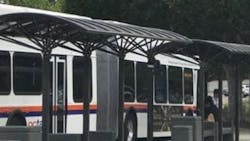OCTA updates Signal Synchronization Program, inks contract with LYT
The Orange County Transportation Authority (OCTA) has updated its Signal Synchronization Program to continue to improve travel times, reduce vehicle emissions and enhance the overall road safety throughout Orange County, Calif. The program is funded by the voter-approved half-cent sales tax for transportation known as Measure M.
“For more than a decade, OCTA has strategically invested in signal-synchronization projects that optimize existing roadways, minimizing the need for costly new infrastructure and helping people get where they need to be efficiently,” said OCTA Chair Tam T. Nguyen. “This program not only eases congestion, but also contributes to cleaner air and a more sustainable future for our community.”
Since the program began in 2008, highlights of the program include:
- Allocating approximately $102.6 million on a competitive basis
- Successfully completing 107 projects along 954 miles of roadway
- Benefiting more than 3,700 signalized intersections across Orange County
OCTA says signal synchronization involves the coordination of traffic signal systems across multiple jurisdictions, allowing for drivers to travel more efficiently with more green lights and fewer stops and idling. The program requires extensive collaboration among local agencies. By synchronizing traffic signals, OCTA enhances the flow of vehicles and improves safety for all road users, including pedestrians and cyclists.
Through the program, OCTA facilitates annual competitive calls for funding, allowing agencies to access 80 percent of funding through Measure M, complemented by 20 percent in matching local funds. The program also leverages additional resources, such as state funds through Senate Bill 1 – the Road Repair and Accountability Act of 2017 – and Solutions for Congested Corridors grants.
Recent data from the program shows:
- Average travel time has been reduced by 13 percent
- Average number of stops has decreased by 29 percent
- Drivers are enjoying an average speed increase of 14 percent, leading to savings on fuel costs.
OCTA notes that by reducing stops and optimizing traffic flow, the program decreased greenhouse gas emissions by an estimated 1.27 billion pounds, significantly contributing to regional air quality improvement.
OCTA continues to look to the future, with 26 additional signal synchronization projects in various stages of implementation, which will synchronize an additional 1,362 signalized intersections and cover 268 miles of roadway.
On Sept. 23, the OCTA Board of Directors approved the release of the invitation for bids, initiating a competitive procurement process for the construction of signalized intersection infrastructure along three signal synchronization projects in south Orange County: Bake Parkway and Rockfield Boulevard, Crown Valley Parkway and Moulton Parkway. The construction associated with the procurement will support the implementation of signal synchronization timing plans to enhance traffic flow and reduce congestion.
LYT
On Sept. 19, LYT signed a contract with the OCTA and the city of Fullerton, Calif., for a one-year pilot program and the implementation of LYT's NextGen transit priority solution (TSP), LYT.transit.
Serving as the primary contractor for TSP under the Master Service Agreement with Arcadis, LYT.transit will help solve congestion issues for traffic signals across the busy corridor of Harbour Boulevard. The Orange County TSP deployment extends LYT's expansion throughout the west coast.
LYT.transit moves bus transit vehicles through congested intersections faster, safer and more intelligently, according to the company. Harnessing the power of a single-edge device installed in the Traffic Management Center (TMC), bus transit vehicles speak directly to networked traffic signals through LYT's open architecture cloud platform, resulting in a consistent and reliable green light for bus transit vehicles in the network.
LYT's system uses automotive data in an actionable way as it takes a broader traffic pattern ecosystem into account to have an impact on other surrounding signals, not just the one signal that traffic is heading toward.
"As the southern California region continues to thrive, it is essential to implement advanced traffic signal prioritization technology to improve the daily commutes of Orange County residents," said Tim Menard, founder and CEO, LYT. "Our cutting-edge AI-powered technology ensures smoother traffic flow, reduces congestion and enhances safety on today's roads. By prioritizing public transportation and optimizing traffic signals, we are committed to creating a more efficient and sustainable transportation network that benefits all residents and businesses throughout Orange County."
"We are pleased to partner with LYT on LYT.transit, to help ease the impacts of traffic congestion for buses in Orange County. By harnessing the power of advanced AI and machine learning, LYT.transit is set to elevate transit efficiency, enhance safety and contribute to a more sustainable transportation network for the residents and businesses of Orange County,” said ITS and Connected Mobility Market Leader at Arcadis Gabriel Murillo.
About the Author
Brandon Lewis
Associate Editor
Brandon Lewis is a recent graduate of Kent State University with a bachelor’s degree in journalism. Lewis is a former freelance editorial assistant at Vehicle Service Pros in Endeavor Business Media’s Vehicle Repair Group. Lewis brings his knowledge of web managing, copyediting and SEO practices to Mass Transit Magazine as an associate editor. He is also a co-host of the Infrastructure Technology Podcast.

